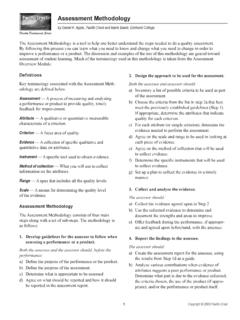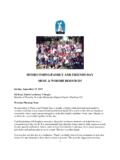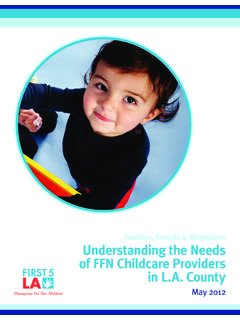Transcription of Chapter 6: Family, Friends, and Other Informal Supports
1 AGING MATTERS. Chapter Six: family , friends , and Other Informal Supports Dr. Babcock We All Need Informal Social support Social support is informational, emotional, or instrumental assistance from your social networks. The benefits of social support : Improved health status, increased morale and self-confidence, reduced depression and anxiety Reduced risk of disability and even death Increased feelings of personal control, autonomy, and sense of being competent, including when dealing with stress Improved cognitive abilities (memory and learning). Diminished negative effects of adverse and stressful life events Copyright (c) 2015 Pearson Education, Inc. All rights reserved. We All Need Informal Social support Do social Supports change as we age? Reciprocal exchanges means being able to help others who assist them. What factors affect our social relationships? Health status Gender Race Social class Copyright (c) 2015 Pearson Education, Inc. All rights reserved.
2 The Centrality of family Supports The family is older adults' most important source of Informal support and encompasses a diverse array of relationships. Fictive kin provide the kind of love and support that healthy family members do for each Other . Families are changing: More couples living together but choosing not to marry More couples choosing not to have children A decline in the percent of children in the total population More unmarried couples raising children More single women having children without a male partner to help raise them More gay and lesbian couples raising children More mothers of young children working outside the home More interracial marriages Copyright (c) 2015 Pearson Education, Inc. All rights reserved. The Centrality of family Supports : The Growth of the Multigenerational family Multigenerational families is defined by at least two adult generations and one Other generation older or younger. Skipped-generation households are those in which a parent is not present in the household.
3 This type of household has increased dramatically. 20% of adults 25-34 and 20% of adults age 65 and older now live in multigenerational households, frequently for financial reasons. Copyright (c) 2015 Pearson Education, Inc. All rights reserved. Older Partners as Social support Older adults and marriage: Nearly 55% of older adults are married and live with a spouse. 42% of women and 72% of men age 65 and older are married and living with a spouse. About 11% of women and 9% of men are divorced or separated. Only 15% of women and 60% of men age 85 and older are married. LGBT older adults are less likely to be partnered. Copyright (c) 2015 Pearson Education, Inc. All rights reserved. Older Partners as Social support Empty nest is when children leave home for college or a job, leaving the home empty.. Marital satisfaction: The physical and emotional benefits from having a spouse or a partner are related to the quality of their relationship. Divorce in old age: The pattern of long-term marriages and lower divorce rates for adults over age 65 is declining and more elders in future cohorts will be divorced and single.
4 Remarriage and Other late-life romantic relationships: Separation, divorce, or the death of a spouse does not have to be the end of an older adult's romantic life. Dating in old age: Single older people got on dates just like younger people who are single do. Copyright (c) 2015 Pearson Education, Inc. All rights reserved. Older Partners as Social support : Never- Married Older People Approximately 4% of the older population has never married. The majority of never-married older persons typically develops reciprocal relationships with Other kind, especially siblings, and with friends and neighbors;. they may not feel lonely or isolated. Never-married adults who have had lifelong employment tend to enjoy greater financial security in old age. Copyright (c) 2015 Pearson Education, Inc. All rights reserved. Older Partners as Social support : Childless Older Adults Approximately 20% of those age 85 and older are childless. The growing number of childless and unmarried younger adults may affect the proportion of older people who will seek formal Supports and develop alternative living arrangements, such as cohousing, in the future.
5 Copyright (c) 2015 Pearson Education, Inc. All rights reserved. Older Partners as Social support : Lesbian, Gay, Bisexual, and Transgender (LGBT). Partners A major social trend that differs from previous generations is the greater openness related to sexual identity; gerontological family research has expanded to include LGBT individuals. There are obstacles to obtaining data, however. What we now know about older LGBT families: They are as diverse as families headed by heterosexual adults. Effects of race, class, and cohort with sexual identity: Some studies suggest that the aging experience of gays and lesbians is qualitatively different. Barriers to Supports for LGBT elders: LGBT adults face disparities and legal and policy barriers that can affect their well-being in old age. Working with LGBT elders: In a study, 21% of LGBT older adults had not revealed their sexual orientation to their primary physician, interfering with adequate diagnosis and prevention.
6 Copyright (c) 2015 Pearson Education, Inc. All rights reserved. Sexuality, Intimacy, and Emotional support Intimate bonds are a vital source of emotional support , no matter what one's age. Copyright (c) 2015 Pearson Education, Inc. All rights reserved. Other Types of family Supports Relationships with adult children Sibling relationships Blended families are those families structured through remarriage. Grandparenthood and great-grandparenthood Intimacy at a distance: strong emotional ties among family member even though they do not live near each Other friends and neighbors as social support Programs to strengthen or build neighborhood and community Supports Natural helpers: nonfamily members that others can turn to Gatekeepers: people in service positions who can fulfill natural helping functions Neighborhood and community building Copyright (c) 2015 Pearson Education, Inc. All rights reserved. Other Types of family Supports Intergenerational programs link older people with schoolchildren, high-risk youth, children with special needs, and young families.
7 The unconditional love of pets: Having a pet to feed, groom, or walk can provide structure, a sense of purpose, and an anchor in days that might otherwise lack meaning. Having a pet may even serve to reduce depression. Copyright (c) 2015 Pearson Education, Inc. All rights reserved.



















